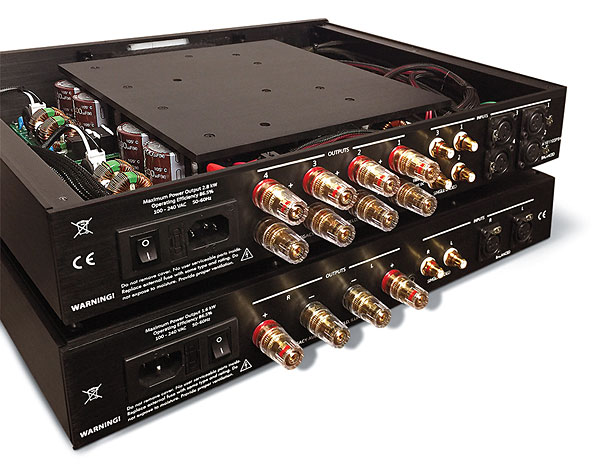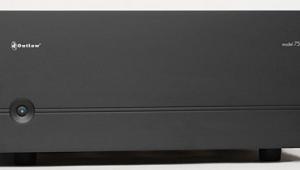Legacy Audio Powerbloc2 and Powerbloc4 Amplifiers Review

AT A GLANCE
Plus
High power in compact, Class D package
Dynamic, uncolored sound
Runs relatively cool
Minus
Channel configurations not ideal for typical surround layouts
THE VERDICT
All the power most will ever need, with the sound quality you want in a slim, cool-running package.
Power amplifiers are God’s gift to the long-suffering audio reviewer, his (or her) compensation for all those A/V receivers, smart-streamers, net-connected speakers, and assorted other CPU-centric components that gray and thin our hair. No arcane MAC or IP addresses for the power amp; no obfuscatory wireless setup routines, stubbornly mute computer connections for auto-EQ procedures, or HDMI ports that refuse to shake hands with other HDMI ports. Whatever its provenance, the power amp demands little more than audio inputs, speaker outputs, and a power cord and calls it good.
Sure, that’s bound to change and probably already has; if you can buy an Internet-of-Things toilet, you doubtless can find a net-connected power amp. But for now, let’s revel in the glory of simplicity, in the form of a new power amp family from Legacy Audio. A tenaciously small, founder/designer-owned American company out of Springfield, Illinois, Legacy is renowned for its excellent, semicustom loudspeakers, having produced some very good ones indeed over the past few decades, with some of the finest woodworking and finishing you’ll find on an audio product (or elsewhere).
For many years, though, Legacy has also offered a select range of electronics. The latest models are the Powerbloc amps, which the company frankly bills as “serious power at a fair price.” The Powerbloc2 and Powerbloc4—identical but for their onboard complements of (duh!) two and four channels, respectively—are slim, light, compact Class D designs based upon the ICEpower technology of Denmark’s ICEpower a/s. (ICEpower arose from a cooperative research/development program between the Technical University of Denmark and the equally Danish audio firm Bang & Olufsen. The spin-off, still in Denmark, produces Class D amplifier modules and licenses its technology for devices ranging from Samsung smartphones to Aston Martin autos to five-figure powered speakers.)
Legacy founder Bill Dudleston is perfectly forthright in the Powerblocs’ owner’s manual (you can find this online) about Class D, laying out a bit of history and why the company opted for today’s generation of ICEpower modules—which set new benchmarks for bandwidth, output impedance/damping factor, and current capability. The Powerbloc2 and Powerbloc4 each pack pairs of ICEpower ASC700-series modules—mono modules in the first case, stereo in the second—with the distinction that each module’s power-supplies current capacity of 30 amps is the same. This means that while steady-state power-per-channel is identical (325 watts or 650 watts into 8 or 4 ohms, respectively), the two-channel amp enjoys an individual power supply for each channel and thus qualifies as a true dual-mono design—and it should have substantially more headroom.
(Geek hats on, please: Earlier generations of Class D amps often presented relatively high output impedances, which made them comparatively more interactive, frequency-response-wise, with the range of loudspeaker loads they might be connected to. This probably had more to do with their Class D “sound” than any peculiarities of their actual amplification. Legacy claims very low output-Z for the Powerbloc models and thus damping factors greater than 1,000 below 1 kilohertz. Translation: solid control, we hope, over big woofer cones.)
Setup
Legacy sent us a sample of each model. The Powerbloc2 and Powerbloc4 are cosmetically identical, with unfussy, sturdily built all-aluminum black-anodized chassis, fascia, and top cover. The only control is a single rocker switch for power on the front panel. When thrown, this illuminates a small logo directly above in thrilling blue; the small “Powerbloc2” or “Powerbloc4” in this window is the only visually distinguishing mark. If, for any reason you find the light bothersome while listening to music or watching movies in a dark room, there’s always electrical tape.

Once you get around back, you’ll find either two pair or four pair of solid, WBT-brand gold-plated multi-way speaker posts, and similar quantities of both unbalanced (RCA) and balanced (XLR) input jacks. Each amp provides an IEC-type threeprong power-cord receptacle for a removable cord, integrated with a master-power switch and fuse, and each supplies a 1/8-inch 12-volt trigger jack to power the amp up and down in tandem with associated gear (such as a preamp or processor). When I peeked inside, I found the layout tidy and carefully arranged, though the ICEpower modules within still leave plenty of room for air circulation. The Powerblocs are passively cooled—no fans—and so remain completely silent (or nearly so, as noted below).
I opted for the simplest-possible setup. First, I connected my Oppo BDP-105D Blu-ray player directly to the power amplifiers. (The Oppo incorporates simple bass-management and volume-control preamp functions, as well as seven-channel analog output from excellent digitalto-analog conversion.) I then connected my five passive loudspeakers likewise, with the Powerbloc2 driving the main left/right speakers, and Powerbloc4 channels 1 through 3 handling the center and surrounds. (Later in my listening, I set up a temporary, single back-surround speaker, in order to exercise all six channels of the two amps.) A sextet of high-quality 1-meter RCA cables did the connecting, while my everyday complement of heavy speaker wires, all terminated with banana plugs, conveyed the outputs.
Listening
With everything in place, I fired up both amps. Not a trace of a turnon thump (or as the British so charmingly term it, “fridge-plop”) was to be heard. (And there was only a bare “tick” on turn-off.) The Powerbloc2 ran dead-quiet. Even when I put an ear an inch from woofer, midrange, or tweeter, no trace of hum or buzz was evident
on either channel. The Powerbloc4 wasn’t quite as tomb-like, but it was still fairly quiet. (A first Powerbloc4 sample had exhibited a substantial audible hum/buzz, so Legacy sent a second sample post-haste, which worked normally.) I elected to begin with pure stereo listening to the Powerbloc2 alone, via my longserving Energy Veritas 2.3 standmount monitors running full range (no subwoofer). This compact three-way speaker is fairly low in sensitivity and adequately full range, and it presents a modestly complex impedance load, so it serves as a suitable amplifier wringer-outer.






























































